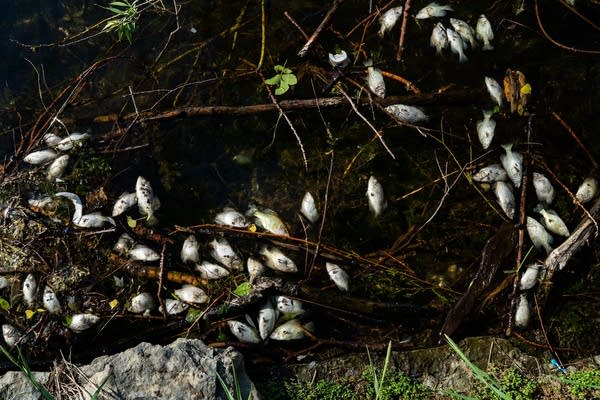Dead fish: Stinky and unsightly, but not cause for alarm

Go Deeper.
Create an account or log in to save stories.
Like this?
Thanks for liking this story! We have added it to a list of your favorite stories.
Dead fish have been washing up on the shores of some Minnesota lakes, but the phenomenon isn't out of the ordinary.
The sight of bloated fish carcasses can be disturbing, especially in large numbers. But experts say it usually doesn't mean the lake is unsafe or its fish population is in jeopardy.
More likely, the fish succumbed to winter kill — the depletion of dissolved oxygen in the lake while it was covered with ice — or a disease prompted by the stress of rapidly warming water and spawning, said Sean Sisler, aquaculture and fish health consultant with the Minnesota Department of Natural Resources.
Sisler said DNR staff were expecting to see more winter fish kills this year because of the unusually long, cold winter, which left lakes frozen until May.
Turn Up Your Support
MPR News helps you turn down the noise and build shared understanding. Turn up your support for this public resource and keep trusted journalism accessible to all.
"You get a thick snow cover on top of the ice, and then that cuts off the light to any plans that might be growing and producing oxygen," Sisler said. "Then basically, you've got no additional inputs of oxygen into the lake."
The sudden spring warm-up also put additional strain on fish, Sisler said.
"We had a very short spring season, so it went from having ice on to almost just before the opener to having like 80 degree days," he said. "That's a big temperature change for fish, so that can definitely stress them out."
Fish likely claimed by winter kill washed up at some Twin Cities lakes, including Lake Nokomis in Minneapolis, where dead crappies were scattered along the shore.

"It happens almost every year, because the conditions can be right for it, and sometimes it's more prevalent in certain lakes than others," said Deb Pilger, director of environmental management for the Minneapolis Park and Recreation Board.
Fish kills often get noticed more in the metro because of the popular walking trails that surround the lakes, Pilger said.
"There's a lot more people out all times of day," she said. "And they love these lakes and they're concerned about them ... They want to reach out and let people know, 'I saw some dead fish. Is everything OK at the lake? Can I swim in it still? Can I fish in it?'"
Pilger said yes, it's safe to swim and fish in the lakes. She said the number of dead fish this year isn't out of the ordinary.
"We're not seeing these huge, huge fish die-offs. It's not at that level of concern yet," she said.
Now that the ice has been off lakes for a few weeks, dead fish washing up on shore are more likely victims of disease, Sisler said.
Fish diseases are always present in the water, but fish are more likely to get sick in spring when they are stressed from warmer temperatures and spawning, he said.
A good indicator that a fish kill is related to disease is if all the fish are the same species and similar size, Sisler said. He said fish diseases rarely affect humans.
Fish kills also could be the result of a human cause, such as a manure spill, fertilizer runoff or large discharge of wastewater. Sisler encourages people to report all fish kills to the state duty officer by calling 1-800-422-0798.



